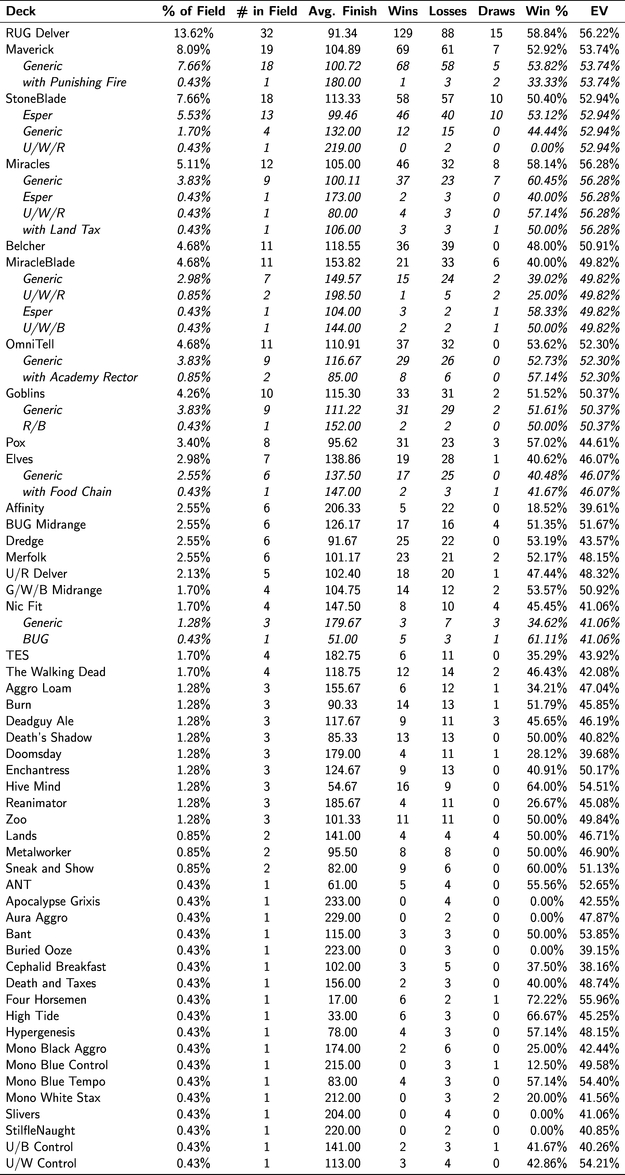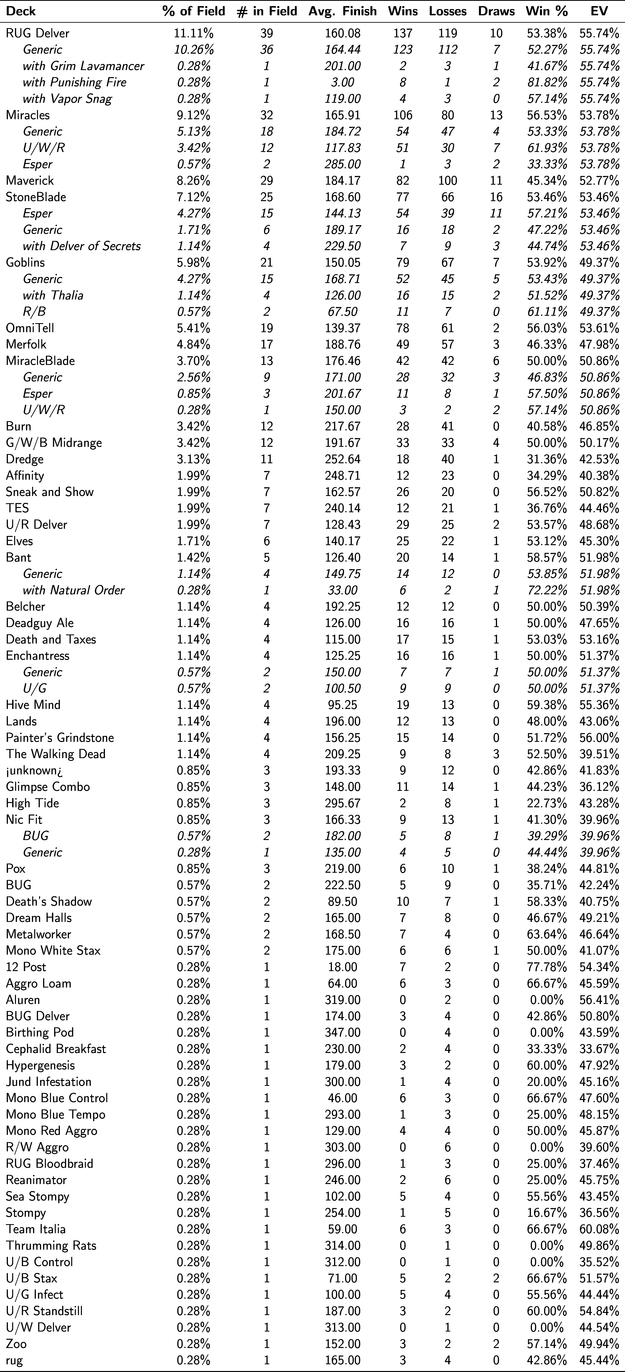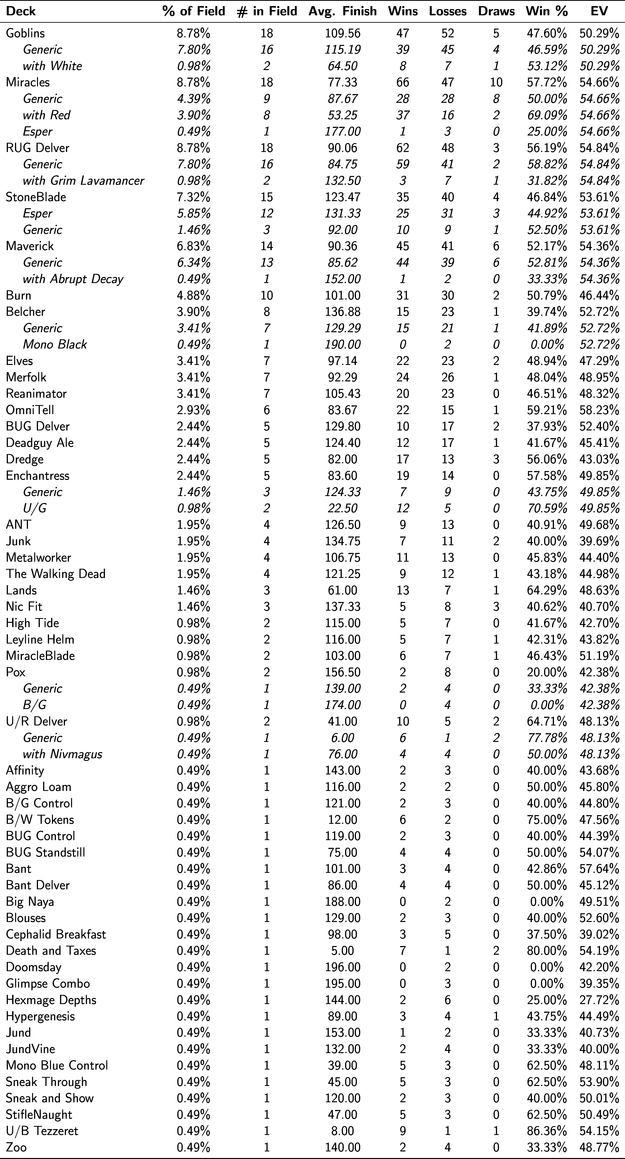It’s been quite some time since we’ve been able to offer up our analysis of the Legacy metagame. We apologize for the absence! The good news, though, is that we’ve accumulated a lot of data between then and now, so we have some nice, solid benchmarks to compare recent numbers with.
We’ll start with SCG Legacy Open: Los Angeles:
Â
Â
At first glance, not much seems to have changed since we last examined Legacy. RUG Delver is still perched at the top of the heap, with an impressive win percentage to back up an even more impressive field percentage.
Maverick comes next with a distant second in field presence (although still quite popular by Legacy standards) and a reasonable win record.
Stoneblade was played by almost as many players as Maverick, but it performed a little worse, barely breaking even.
The fourth deck in our list is newer than the top three. U/W Miracles had just entered the scene when our last TMI article was published, but it has since become a staple of the format. And no wonder, with it boasting a win percentage in LA that rivaled RUG Delver’s. Its high Expected Value hints that this was no fluke, which we’ll come back to.
The next thing to note is Omni-Tell, another recently created deck, which won a greater percentage of its matches than Maverick but didn’t get close to the success of U/W Miracles or RUG. Like Omni-Tell, Goblins also made up a little less than five percent of the field, but it had a decidedly mediocre performance. Conversely, Pox did extraordinarily well, drastically outperforming its EV.
Now for the SCG Legacy Open in Atlanta:
Â
Â
More RUG Delver dominance in Atlanta. Making up more than ten percent of the field and still with a healthy win percentage (although down considerably from that of LA), RUG remained the most important deck of the event. However, there’s more to the story than that.
Right behind RUG in popularity we see U/W Miracles, up two slots from the previous event, and it maintained an impressive win ratio. Notice that it was the jump in U/W Miracles’ prevalence, not a decline in either Maverick’s or Stoneblade’s, that caused this rearrangement in the list.
Maverick had a rare bad day in Atlanta. Winning just over 45% of its matches, the G/W deck came in well under its EV for the event. One has to wonder if this was partially because of the jump in U/W Miracles players well prepared for the matchup.
Stoneblade improved on its showing in LA but was still surpassed by rival U/W Miracles.
Goblins and Omni-Tell were both marginally more popular (and successful) than they were in LA. For one of these decks, this was foreshadowing of Cincinnati.
Speaking of which:
Â
Â
Occasionally, alphabetizing just happens to order things for maximum shock value without us having to do so blatantly. Look at this chart! Not only is RUG Delver not at the top, but it’s been bumped all the way to third!
The trick of perception is warranted, in this case. Yes, RUG still tied for most popular deck, but the fact that not one but TWO other decks managed to match it is worth every Legacy player’s notice. In LA, ten people played Goblins, twelve people played U/W Miracles, and 32 people played RUG Delver. Apparently, some of those 32 people decided to drop RUG for the other decks in the meantime.
Were they rewarded? Not if they chose Goblins. While the green army had a respectable win percentage in Atlanta, it got routed on what should have been its day in the sun. Well, “rout” may be too strong a word to describe a 47.6% win record, but that number is certainly not as impressive as the popularity statistic.
Those players that jumped the RUG ship to play U/W Miracles weren’t disappointed, though. It was the only deck among the top ten that did better than RUG, and RUG had a terrific performance.
Stoneblade was still about seven percent of the field in Cincy. That didn’t change much across these three events. However, its win ratio plummeted in this last event. It came in under the deck’s EV by almost seven points!
Maverick did drop in popularity, coming in under Stoneblade for once. At least its players had a better day in Cincy than they did in Atlanta! Also, although a 52% win percentage may seem underwhelming, Maverick was still the third-best performing deck among the ten most popular decks in this tournament (behind the juggernauts RUG and U/W Miracles).
In fact, none of the other popular decks did much better than split even. It seems that having two decks tied for most popular and boasting win percentages close to 60% takes a toll on the numbers throughout the rest of the field. After all, there are only so many match wins to go around!
Skipping past Burn, Belcher, Elves, Merfolk, and Reanimator, all of which were poor choices for this event, we finally come to Omni-Tell with a staggeringly positive 59% win percentage. Its six pilots made up less than three percent of the tournament, but at least the high win percentage seems corroborated by the deck’s EV.
Let’s look at some of the top decks in detail, combining the numbers from these events:
RUG Delver â⒬” 11.25% of field â⒬” won 55.97% of matches
Â

Â
Legacy’s persistent boogeyman remained not only popular but successful as well. We have an awful lot of data collected about RUG’s matchups at this point, especially those against Maverick and Stoneblade, which appear slightly unfavorable and slightly favorable, respectively. There are some interesting things about this set of data, though.
First of all, the Miracles matchup appears to have gotten worse. The rise of that deck could certainly be explained by an ability to handle RUG, but prior to these tournaments that isn’t what the numbers indicated. Now, though, it seems that RUG may only be able to split with Miracles.
The Goblins matchup, on the other hand, looked much worse for RUG beforehand. The change may be the result of RUG players adopting tools such as Grim Lavamancer and especially Rough / Tumble, which are effective at helping address swarm strategies.
We have less data about Omni-Tell than about any of the other decks, but RUG’s failure to stay ahead in that contest disagrees with what prior information we do have. It may take more time to find out which deck is favored here.
Maverick â⒬” 7.84% of field â⒬” won 49.29% of matches
Â

Â
This group of tournaments wasn’t good for Maverick. Although it won a little more than half of its matches in LA and Cincy, the G/W deck’s miserable showing in Atlanta brought its win ratio across the three events down to less than even. The matchup chart looks even worse.
Maverick still appears to hold an edge against RUG, which is no small feat, but its other matchups against the top decks range from poor to horrid. Two of them, Stoneblade and Goblins, have historically been positive for Maverick, so these events could either be outliers or those decks could be benefiting from some kind of update. The Miracles matchup, however, is shaping up to be a real challenge for Maverick, which is bad news considering the U/W deck’s recent rise in popularity.
The Omni-Tell matchup seems to be the worst of the bunch, although the sample size is the smallest by far. It’s also unclear whether that deck is destined to become a staple in the metagame or not.
Miracles â⒬” 7.84% of field â⒬” won 57.23% of matches
Â

Â
Legacy’s newest miracles deck enjoyed a solid string of finishes across these three tournaments, which resulted in it having the best win percentage among these decks. It also showed a definite trend of increasing field presence. Could Miracles be in the process of replacing RUG Delver as the best deck in the format?
We don’t have the wealth of statistical information about Miracles that we have for RUG, Maverick, or Stoneblade, but these three events were large enough to lend some weight to this matchup breakdown.
Miracles’ win percentage against the aforementioned decks shows that it certainly could have what it takes to muscle into their ranks. Roughly even against the other blue decks and favored against Maverick, Miracles doesn’t look out of place at all. Next, we see a reasonable (probably close to even) matchup against Goblins and what looks like a heavily favorable matchup against Omni-Tell.
Not one of these matchups is unfavorable, which probably explains how Miracles managed such a high win percentage overall.
Stoneblade â⒬” 7.33% of field â⒬” won 50.96% of matches
Â

Â
Legacy’s previously premier miracles deck has fallen some from its peak performance numbers. This is obvious by comparing the overall matchup numbers, which have a lot of statistical weight behind them, with those from these recent tournaments.
The RUG versus Stoneblade matchup, long one of the most important in the format, has always been very close. The relatively small number of matches played between these decks in these events isn’t necessarily indicative of that changing, but Stoneblade only winning 43% of them still isn’t encouraging.
The fact that Stoneblade beat Maverick 54.41% of the time is encouraging, but its significance is subject to the same doubt.
The other three matchups are worth looking at a little more closely just because we don’t have as much overall information to compare them to. Those numbers show more close matchups against Miracles and Omni-Tell and what may very well be a terrible matchup against Goblins.
Stoneblade doesn’t really look bad by these numbers, but it doesn’t look good either (hence the mediocre win percentage!). Stoneforge Mystic certainly doesn’t look as good as Terminus does.
Goblins â⒬” 6.19% of field â⒬” won 51.39% of matches
Â

Â
Goblins has been part of Legacy since the format’s inception, and, amazingly, the deck’s design hasn’t significantly changed much since then. It has picked up new toys along the way, though, most recently with the printing of Cavern of Souls. Is that what has caused this latest spike in popularity?
Making up a little more than six percent of the combined field and winning a little more than losing doesn’t make for much of an entry in any account of Goblins’ extensive history, but it’s noteworthy for the current era. This is evident in the dearth of overall data we have for the deck despite it obviously existing for the entire duration of our collection period.
Based on what we have, Goblins appears to be prone to having somewhat lopsided matchups. However, several of the striking numbers from these three events contradict the numbers we have from the rest of the year. Has this been caused by the addition of Cavern of Souls or some other change in deck construction? Or is it simply due to the fluctuations caused by smaller sample sizes?
In either case, it’s unclear whether Goblins is favored or unfavored against RUG, Maverick, or Miracles. It’s matchup against Stoneblade is very good, though, and the addition of Cavern may very well have made it even better.
Goblins losing to Omni-Tell isn’t much of a surprise, but, as mentioned before, we don’t know how important that will be in the future.
Omni-Tell â⒬” 4.55% of field â⒬” won 55.85% of matches
Â

Â
Omni-Tell, which combines a Show and Tell package with the new card Omniscience as a superior Dream Halls effect, is a powerful new combo deck and the only combo deck popular enough to consider analyzing. We still don’t have a whole lot of data for it, but the deck’s novelty and win percentage make up for that.
It looks like Omni-Tell is definitely capable of beating RUG and Stoneblade, which is impressive for a Legacy combo deck. The Miracles matchup, however, looks pretty abysmal.
Of course, the combo deck seems hugely favored against Maverick and Goblins, so there’s nothing unusual there. If Omni-Tell can continue to perform like this, it stands well poised to become a key part of the Legacy metagame.
Thus ends our detailed look at the SCG Legacy Opens in Los Angeles, Atlanta, and Cincinnati. We had to take a long hiatus from writing TMI articles, and as a result there were quite a few tournaments that we won’t have the chance to analyze in detail. We have added all of the data to our database, though, and here we’ll summarize it graphically for anyone who is interested. These graphs start with the SCG Legacy Open in Las Vegas back in July and show all of the SCG Legacy Opens between then and Cincinnati. The first shows the field presence of all decks to make up at least five percent at any point along the way, and the second graph shows the win percentage of those same decks:
Â
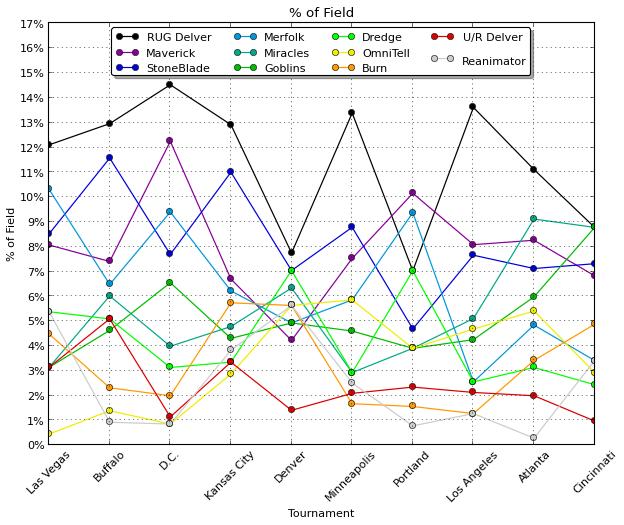
Â
Â
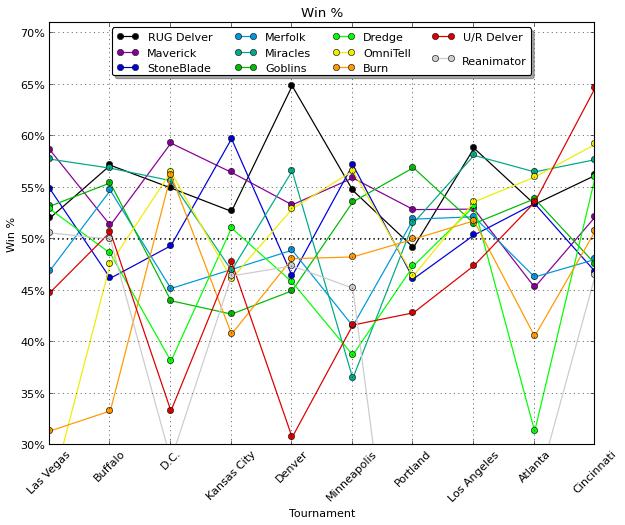
Â
As expected, RUG Delver was the most popular deck throughout. Maverick and Stoneblade spent the bulk of that time fighting for second. Merfolk enjoyed some popularity during the summer, but it seems to have dropped off lately. Miracles, on the other hand, had existed for some time but didn’t appear among the top decks before Atlanta. RUG and Maverick were the most consistent performers over all ten events, as they had been for some time before.
Much of what we saw in LA, Atlanta, and Cincy is similar to what was happening earlier in the year, but all was not as expected. The jockeying between Terminus and Stoneforge Mystic is probably the most interesting thing happening at the top of the Legacy metagame right now. Up until now, Stoneblade has remained popular, but Miracles consistently outperformed it in these tournaments and the Terminus deck’s popularity certainly seems to be trending upward. Speaking of Terminus decks, there are a non-trivial number of Miracleblade hybrids out there (they’re in the charts), but so far those variants have performed markedly worse than either of their progenitors.
RUG Delver was still the marquee deck of the format following Cincinnati, but Miracles made a good attempt to dethrone it. When we look at the next set of events, we’ll find out if the U/W deck has more left to prove or if Delver of Secrets will rally. Join us then!
Alix and Jesse Hatfield
Â

